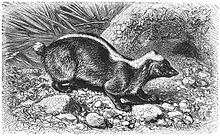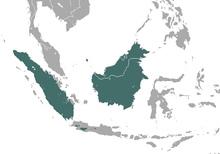Sunda stink badger
| Sunda stink badger | |
|---|---|
 |
|
| Scientific classification | |
| Kingdom: | Animalia |
| Phylum: | Chordata |
| Class: | Mammalia |
| Order: | Carnivora |
| Family: | Mephitidae |
| Genus: | Mydaus |
| Species: | M. javanensis |
| Binomial name | |
|
Mydaus javanensis (Desmarest, 1820) |
|
 |
|
| Sunda stink badger range | |
| Synonyms | |
|
Mydaus meliceps |
|
Mydaus meliceps
The Sunda stink badger (Mydaus javanensis), also called the Javan stink badger, teledu, Malay stink badger, Malay badger, Indonesian stink badger and Sunda skunk, is a mammal native to Indonesia and Malaysia. Despite the common name, they are not closely related to true badgers, and are, instead, Old World relatives of the skunks.
Sunda stink badgers have a similar body shape to badgers, but are significantly smaller, being 37 to 52 cm (15 to 20 in) in total length, and weighing from 1.3 to 3.6 kg (2.9 to 7.9 lb). Their fur is coarse, and black or very dark brown over most of the body, with a white stripe running from the top of the head to the tail. The tail is short, measuring about 3.6 cm (1.4 in), and is covered in pure white fur. The width of the stripe varies considerably between individuals, but is usually narrow, and may be discontinuous. As the name indicates, stink badgers have an anal scent gland that secretes a foul-smelling substance, which the animal can spray up to 15 cm (5.9 in). Females have six teats.
Sunda stink badgers are found in Java, Sumatra, Borneo, and the northern Natuna Islands. Sunda stink-badgers can be found across a wide variety of habitats, including forest edges or areas of secondary forest. Historically they were thought to be restricted to high elevations of over 2,000 m (6,600 ft), and only rarely on lowland plains. This is now known not to be true, and more recent surveys have shown Sunda stink-badgers are often found in elevations well below 2000m. Sunda stink-badgers have been reported as low as 250 m (820 ft) above sea level on Java, at relatively low elevations in Sarawak., and have even been recorded at elevations as low as 10m in the Lower Kinabatangan floodplains, Sabah, Borneo at seemingly high densities.
Three subspecies are recognised:
Sunda stink badgers are omnivorous and nocturnal. The animal portion of their diet consists of invertebrates, eggs, and carrion. At night, they root through soft soil using their snout and claws, searching for worms and ground-dwelling insects. During the day, they sleep in short burrows, less than 60 cm (24 in) in length, which they may either dig themselves or take over from other animals, such as porcupines. They have been reported to give birth to litters of two or three young.
...
Wikipedia

